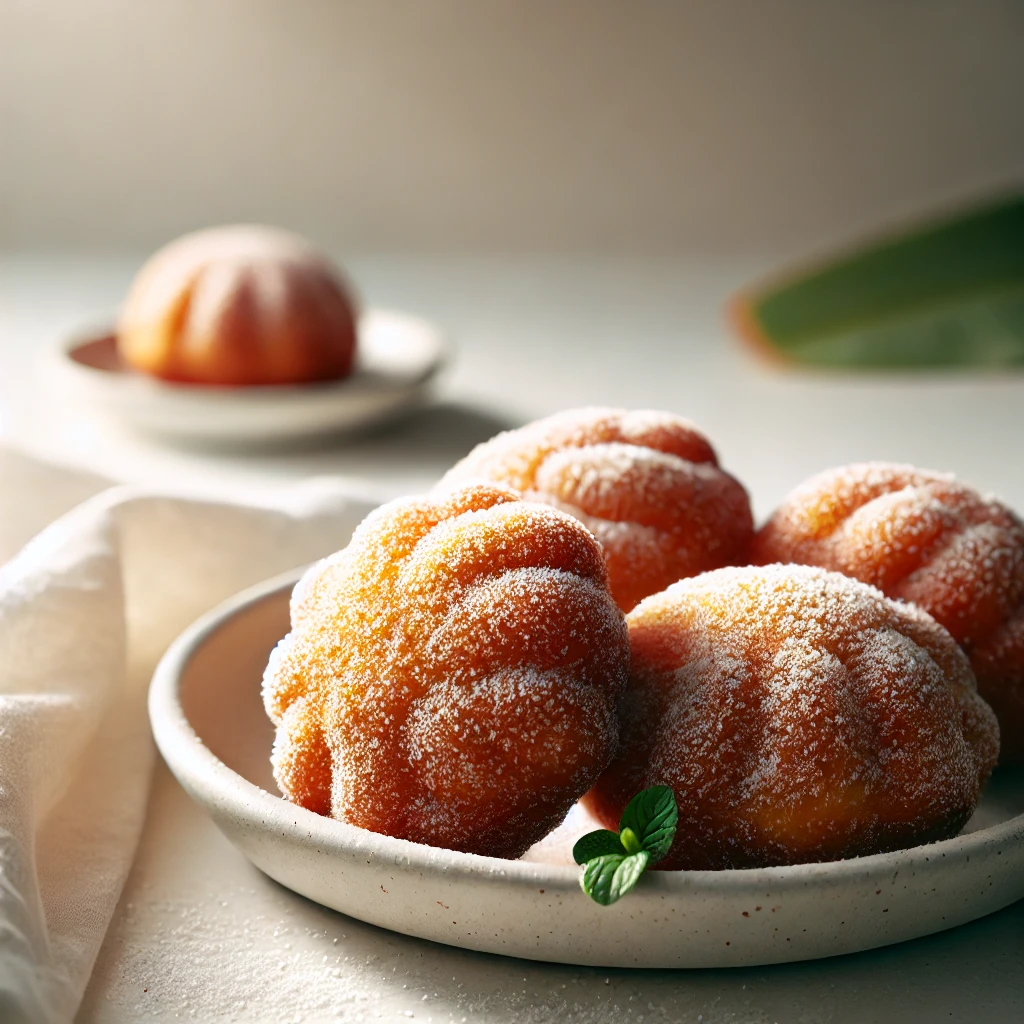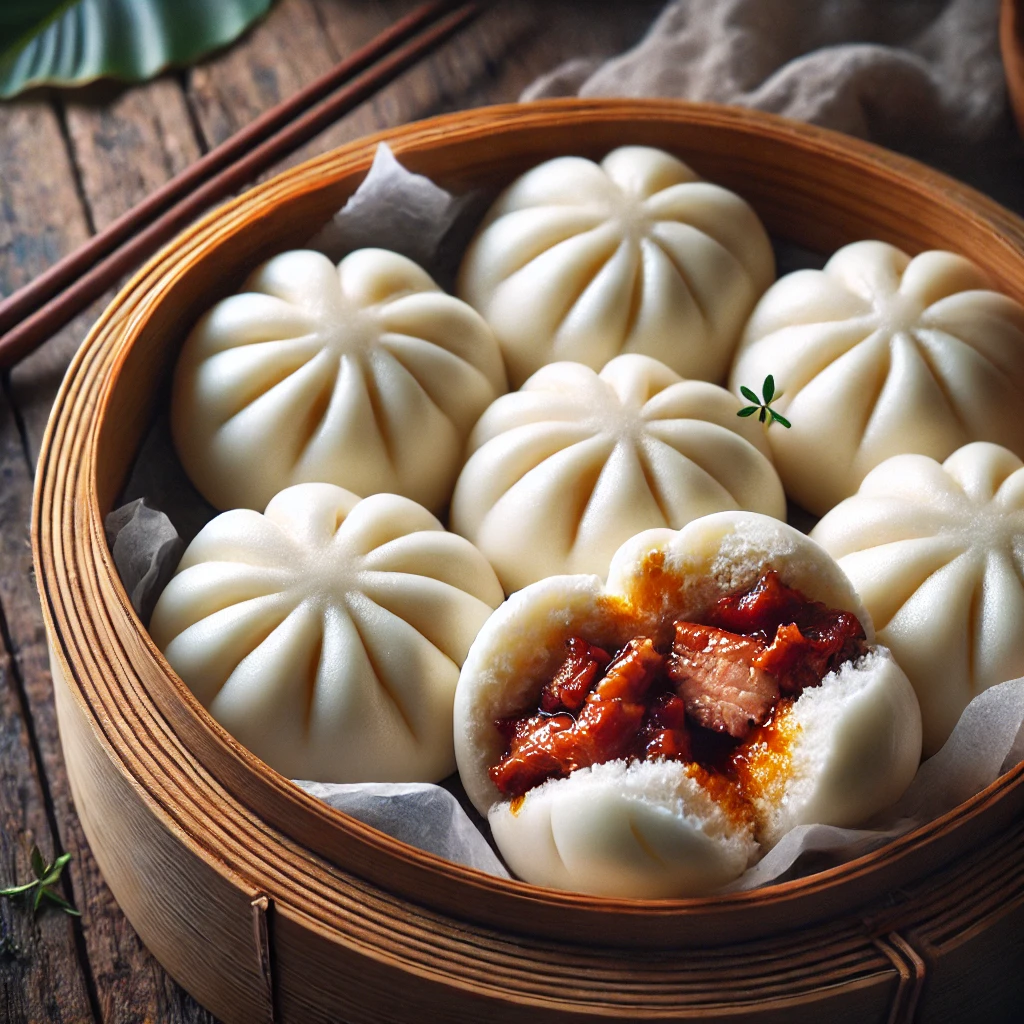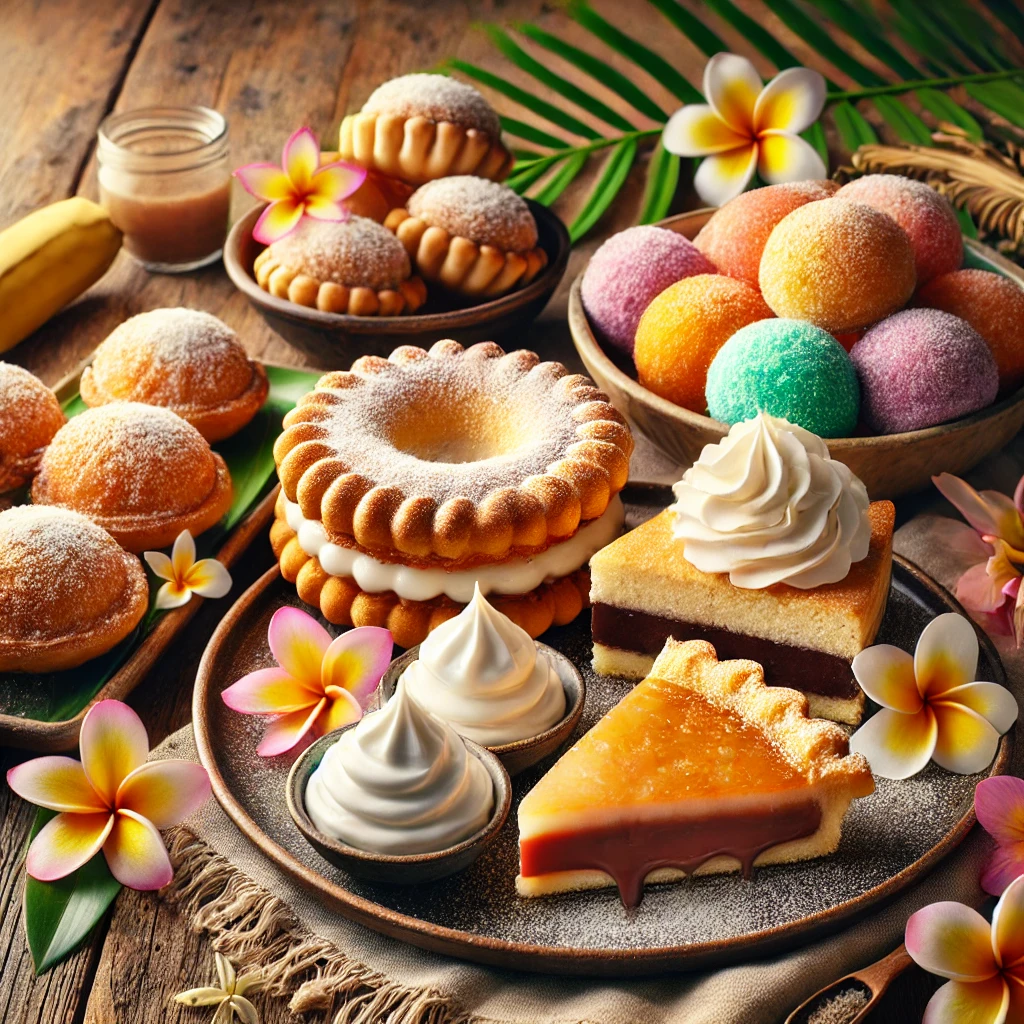Table of contents
- Introduction
- Malasadas
- Haupia Pie
- Manapua
- Poi Mochi
- Chantilly Cake
- Coconut Turnover
- Pineapple Upside-Down Cake
- Macadamia Nut Tart
- Conclusion
- Frequently Asked Questions (FAQs)
- Q: What pastry is famous in Hawaii?
- Q: What is Haupia Pie made of?
- Q: Are Manapua and Char Siu Bao the same?
- Q: How is Poi Mochi different from regular mochi?
- Q: What makes Chantilly Cake unique among Hawaiian desserts?
- Q: Can I make these Hawaiian desserts at home?
- Q: Where can I find Hawaiian desserts outside of Hawaii?
- Q: What are some variations of Coconut Turnovers?
Introduction
Hawaiian Desserts hold a unique place in the world of sweets, bringing tropical flavors and cultural heritage to the table. These desserts not only satisfy sweet cravings but also tell stories of Hawaii’s rich history and traditions. In this article, we will explore what pastry is famous in Hawaii, featuring a variety of delightful treats that showcase the essence of Hawaiian Desserts.
Malasadas
History and Cultural Importance

Malasadas are a cherished part of Hawaiian Desserts, originating from Portuguese immigrants who brought this sweet treat to the islands in the 19th century. These sugar-dusted, deep-fried pastries quickly became a staple in Hawaiian cuisine, especially enjoyed during celebrations and events like Malasada Day, also known as Fat Tuesday.
Traditional Preparation Methods
Traditional malasadas are made with simple ingredients such as flour, sugar, eggs, yeast, and milk. The dough is allowed to rise, then shaped into balls and deep-fried until golden brown. Once fried, they are generously coated with granulated sugar, creating a crispy exterior with a soft and airy interior.
Variations and Modern Twists
While the classic malasada remains a favorite, modern variations have emerged, incorporating fillings like custard, chocolate, and tropical fruits. These creative twists on the traditional recipe add exciting flavors and textures, making malasadas a versatile and beloved choice among Hawaiian Desserts.
Haupia Pie
Origins and Evolution
Haupia Pie is a beloved part of Hawaiian Desserts, derived from the traditional coconut pudding known as Haupia. This dessert evolved by incorporating a pie crust, making it a popular and modern twist on the classic Haupia. The pie’s rich coconut flavor and creamy texture make it a favorite among locals and tourists alike.
Key Ingredients

The key ingredients for Haupia Pie include coconut milk, sugar, cornstarch, and a pie crust. The filling is made by cooking the coconut milk mixture until it thickens, then pouring it into the pre-baked crust. Once set, the pie is topped with a layer of whipped cream, enhancing its creamy and tropical taste.
Popularity in Hawaii
Haupia Pie is widely enjoyed across Hawaii, often found in local bakeries and restaurants. Its refreshing and light flavor makes it a perfect dessert for the warm Hawaiian climate. This pie is a staple at luaus and family gatherings, highlighting its cultural and culinary significance in Hawaiian Desserts.
Manapua
Historical Background
Manapua, also known as Hawaiian steamed buns, are a delicious part of Hawaiian Desserts with origins traced back to Chinese immigrants who came to Hawaii in the 19th century. These buns, also known as char siu bao in Chinese cuisine, have been adapted to reflect Hawaiian flavors and ingredients, making them a staple in local food culture.
Common Fillings

Traditional manapua are filled with sweet char siu pork, but there are many variations available today. Fillings can include chicken, curry, sweet beans, and even local flavors like kalua pork and purple sweet potato. Each variation offers a unique taste experience, showcasing the versatility of manapua in Hawaiian cuisine.
Serving Suggestions
Manapua can be enjoyed as a snack, lunch, or dessert. They are often served warm, either steamed or baked, making them a comforting and satisfying treat. In Hawaii, you can find manapua at local bakeries, food trucks, and even convenience stores, reflecting their widespread popularity and cultural significance in Hawaiian Desserts.
Poi Mochi
Cultural Significance
Poi Mochi is a unique part of Hawaiian Desserts that combines traditional Japanese mochi with Hawaiian poi. Poi, made from taro root, is a staple in Hawaiian cuisine, and when blended with mochi, it creates a dessert that is chewy, flavorful, and deeply rooted in cultural heritage.
Unique Texture and Flavor
The blend of poi and mochi results in a distinctive texture that is both chewy and slightly dense. The flavor is subtly sweet with a hint of the earthy, nutty taste of taro. This combination makes Poi Mochi a delightful and unique treat that stands out among Hawaiian Desserts.
How It’s Made
Poi Mochi is made by mixing poi with glutinous rice flour, sugar, and water to form a dough. The dough is then shaped into small balls and deep-fried until golden brown. This preparation method gives Poi Mochi a crispy exterior while maintaining its signature chewy texture inside.
Chantilly Cake
Origins and Description
Chantilly Cake is a delightful part of Hawaiian Desserts known for its light and fluffy texture. The cake’s origins can be traced back to the French influence in Hawaiian cuisine, combining European techniques with local flavors. It typically features layers of soft sponge cake filled with a rich and creamy Chantilly frosting.
Key Components
The key components of Chantilly Cake include a tender sponge cake base, which is often flavored with vanilla or almond. The standout feature is the Chantilly frosting, made from a mixture of whipped cream, butter, and sugar, sometimes enhanced with a hint of coconut or macadamia nuts. This frosting is spread generously between the cake layers and on top, creating a luscious and indulgent dessert.
Serving Ideas
Chantilly Cake is a versatile dessert that can be served at various occasions, from casual gatherings to special celebrations. It pairs well with fresh fruits, such as berries or tropical fruits, adding a refreshing contrast to its rich flavors. Whether enjoyed with a cup of coffee or as the centerpiece of a dessert table, Chantilly Cake is a beloved choice among Hawaiian Desserts.
Coconut Turnover
Historical Context
Coconut Turnovers, known locally as “Pani Popo,” are a delightful part of Hawaiian Desserts. They have roots in the Pacific Islands and have been embraced by Hawaiian culture. These turnovers are loved for their sweet, coconut-filled interiors and flaky, golden crusts.
Ingredients and Preparation
The primary ingredients for Coconut Turnovers include coconut milk, sugar, and shredded coconut for the filling, along with flour, butter, and water for the dough. The dough is rolled out, filled with the sweet coconut mixture, folded, and then baked until golden brown. The result is a pastry with a delightful contrast between the flaky crust and the rich, coconut filling.
Variations
While the classic Coconut Turnover is always a hit, variations can include adding tropical fruits like pineapple or mango to the filling. Some recipes also incorporate a hint of vanilla or almond extract to enhance the flavor. These twists provide a modern take on a traditional favorite among Hawaiian Desserts.
Pineapple Upside-Down Cake
Background and Popularity
Pineapple Upside-Down Cake is a vibrant and delicious part of Hawaiian Desserts, known for its beautiful presentation and tropical flavors. This dessert became popular in the United States in the early 20th century and quickly gained a special place in Hawaiian cuisine, where fresh pineapples are abundant.
Key Ingredients
The key ingredients for Pineapple Upside-Down Cake include fresh or canned pineapple slices, maraschino cherries, brown sugar, butter, and a simple cake batter made from flour, sugar, eggs, and baking powder. The caramelized pineapple topping is what sets this cake apart, providing a delightful sweetness and visual appeal.
Recipe Tips
To make the perfect Pineapple Upside-Down Cake, arrange the pineapple slices and cherries in a decorative pattern at the bottom of the cake pan before pouring the batter over them. Once baked, the cake is inverted, revealing the beautifully caramelized fruit on top. It’s best served warm, allowing the flavors to meld and the cake to remain moist and tender.
Macadamia Nut Tart
History and Significance
Macadamia Nut Tart is a delectable part of Hawaiian Desserts, known for its rich, buttery flavor and crunchy texture. The macadamia nut, native to Australia, was introduced to Hawaii in the late 19th century and quickly became an integral part of Hawaiian agriculture and cuisine. This tart showcases the unique taste of macadamia nuts, making it a beloved treat.
Key Ingredients
The key ingredients for a Macadamia Nut Tart include macadamia nuts, sugar, butter, eggs, and a pastry crust. The filling is made by combining chopped macadamia nuts with a sweet, buttery mixture, which is then poured into the pastry shell and baked until golden brown.
Serving Suggestions
Macadamia Nut Tart is best enjoyed slightly warm, allowing the buttery filling to meld perfectly with the crunchy nuts. It can be served with a dollop of whipped cream or a scoop of vanilla ice cream, enhancing its rich flavors. This tart is a perfect choice for special occasions or as an indulgent dessert, reflecting the essence of Hawaiian Desserts.
Conclusion
Recap of Famous Hawaiian Pastries
In this article, we explored a variety of Hawaiian Desserts, each with its unique flavors and cultural significance. From the sugar-dusted malasadas to the rich and creamy Haupia Pie, each dessert offers a taste of Hawaii’s diverse culinary heritage. Other delights like manapua, Poi Mochi, Chantilly Cake, Coconut Turnover, Pineapple Upside-Down Cake, and Macadamia Nut Tart showcase the creativity and rich flavors found in Hawaiian cuisine.
Encouraging Readers to Explore Hawaiian Desserts
We encourage you to try these Hawaiian Desserts at home or seek them out at local bakeries and restaurants. Exploring these treats can be a fun and delicious way to experience Hawaiian culture and add a tropical twist to your dessert repertoire.
Final Thoughts on Hawaiian Pastry Culture
Hawaiian Desserts are more than just sweet treats; they are a reflection of Hawaii’s history, cultural diversity, and culinary innovation. Whether you are enjoying a traditional pastry like malasadas or a modern twist like Haupia Pie, each dessert connects you to the rich tapestry of Hawaiian culture. Celebrate the flavors of Hawaii and continue exploring the delightful world of Hawaiian Desserts.
Frequently Asked Questions (FAQs)
Q: What pastry is famous in Hawaii?
A: Malasadas are one of the most famous pastries in Hawaii. These sugar-dusted, deep-fried treats have Portuguese origins and are loved by locals and tourists alike. Haupia Pie, Manapua, and Chantilly Cake are also popular choices among Hawaiian Desserts.
Q: What is Haupia Pie made of?
A: Haupia Pie is made from coconut milk, sugar, cornstarch, and a pie crust. The filling is a creamy coconut mixture that is set in a pre-baked crust and often topped with whipped cream for added richness.
Q: Are Manapua and Char Siu Bao the same?
A: Manapua and Char Siu Bao are similar, but they are not exactly the same. Manapua is the Hawaiian adaptation of the Chinese Char Siu Bao. Both are steamed buns filled with sweet or savory fillings, but Manapua often features local flavors like kalua pork and sweet beans.
Q: How is Poi Mochi different from regular mochi?
A: Poi Mochi combines traditional Japanese mochi with Hawaiian poi, giving it a unique chewy texture and a subtly sweet, earthy flavor from the taro root. This blend distinguishes Poi Mochi from regular mochi, which is made solely from glutinous rice flour.
Q: What makes Chantilly Cake unique among Hawaiian desserts?
A: Chantilly Cake is unique because of its rich and creamy Chantilly frosting, made from whipped cream, butter, and sugar. This frosting is spread generously between layers of soft sponge cake, often enhanced with flavors like coconut or macadamia nuts, making it a luxurious and beloved dessert in Hawaii.
Q: Can I make these Hawaiian desserts at home?
A: Absolutely! Many Hawaiian Desserts can be made at home with readily available ingredients. Recipes for malasadas, Haupia Pie, Manapua, and others are accessible and can bring a taste of Hawaii to your kitchen.
Q: Where can I find Hawaiian desserts outside of Hawaii?
A: Hawaiian desserts can often be found in Hawaiian-themed restaurants, bakeries, and specialty stores across the United States and other countries. Some online retailers also offer Hawaiian snacks and pastries that can be delivered to your doorstep.
Q: What are some variations of Coconut Turnovers?
A: Variations of Coconut Turnovers, or Pani Popo, can include adding tropical fruits like pineapple or mango to the filling. Some recipes may also incorporate vanilla or almond extract for an added flavor twist.

